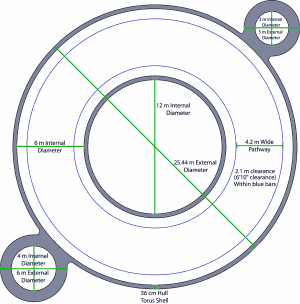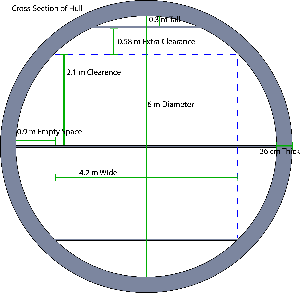 |
 |
 |
 |
Habitat |
 |
 |
 |
 |
 |
Development Hull design Internal Layout Docking Systems Life Support Power Systems Communications Anchoring |
 |
 |
 |
 |
Design of the Atlantis II Hull
![]() Basically, the Atlantis II habitat is shaped like a torus with a pair of spheres attached on opposite sides. It is roughly 30 meters (100 feet) across at its widest point and 6 meters (20 feet) tall.
Basically, the Atlantis II habitat is shaped like a torus with a pair of spheres attached on opposite sides. It is roughly 30 meters (100 feet) across at its widest point and 6 meters (20 feet) tall.

![]() These dimensions for the torus are optimized to provide an impressive floor space while keeping the corridor width small, which allows for a relatively thinner hull. The internal space provided by this hull is similiar to a tube 6 meters in diameter and about 63 meters long. Since the tube is curved into the torus shape, the interior appears as an endless corridor.
These dimensions for the torus are optimized to provide an impressive floor space while keeping the corridor width small, which allows for a relatively thinner hull. The internal space provided by this hull is similiar to a tube 6 meters in diameter and about 63 meters long. Since the tube is curved into the torus shape, the interior appears as an endless corridor.
![]() Next to the habitat's impressive size is its hull thickness. Built entirely out of titanium alloy, the hull is approximately 36 cm (14") thick. This thickness was computed from a standard thickness for maintaining a given pressure difference, where:
Next to the habitat's impressive size is its hull thickness. Built entirely out of titanium alloy, the hull is approximately 36 cm (14") thick. This thickness was computed from a standard thickness for maintaining a given pressure difference, where:

Which implies:


![]() So, for a depth of 3000 meters and an internal diameter of 6 meters with a 50% safety margin (meaning the hull could withstand a depth of 4500 meters), the walls will need to be approximately 36 centimeters thick. Of course, with a titanium alloy hull, the structure is massive. With a 36 cm hull and the 1 m thick docking spheres, there is over 1230 cubic meters of titanium, with a mass of 5.46 million kilograms (6000 tons).
So, for a depth of 3000 meters and an internal diameter of 6 meters with a 50% safety margin (meaning the hull could withstand a depth of 4500 meters), the walls will need to be approximately 36 centimeters thick. Of course, with a titanium alloy hull, the structure is massive. With a 36 cm hull and the 1 m thick docking spheres, there is over 1230 cubic meters of titanium, with a mass of 5.46 million kilograms (6000 tons).
There is one final impressive fact about this hull. It floats. That's right; although this hull is so massive, the sheer size of the habitat displaces 8.51 million kilograms (9300 tons). This forces the habitat to be anchored to the seafloor to prevent it from floating to the surface.
t = wall thickness
Do = outside diameter = Di + t
Di = inside diameter = 6 m
Pe = outside pressure = 300 atm (450 atm x/safety)
u = Poissonís Ratio = 0.342
E = Compressive Yield Strength = 970 Mpa X = Ocean Depth in meters = 3000 m (4500 m w/ safety)
